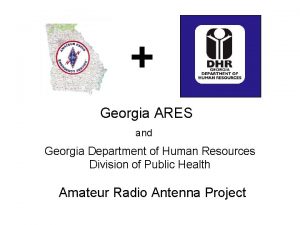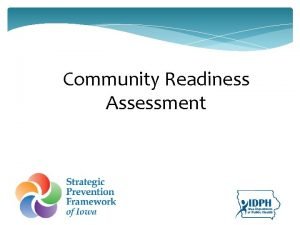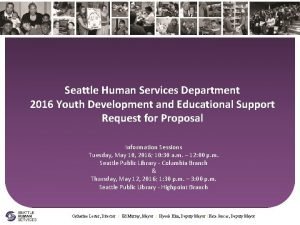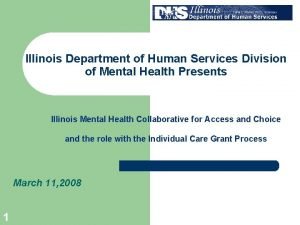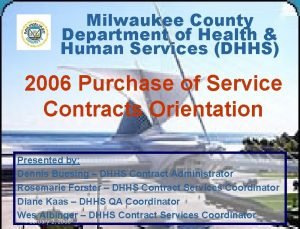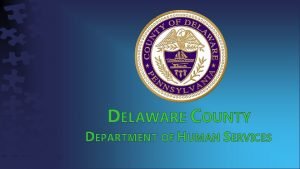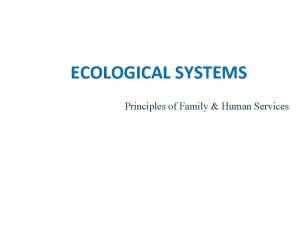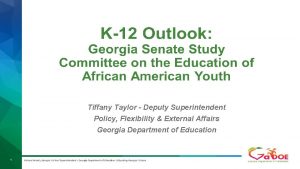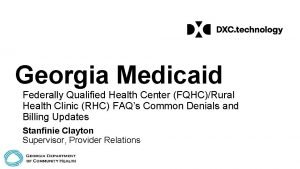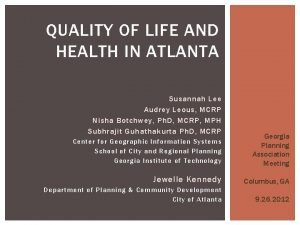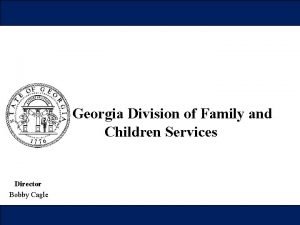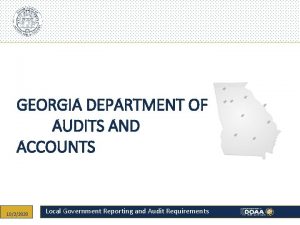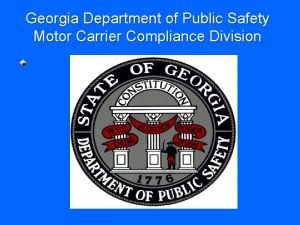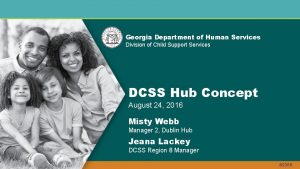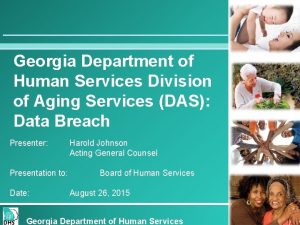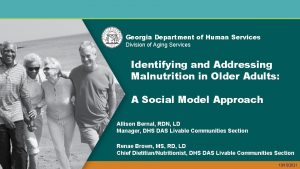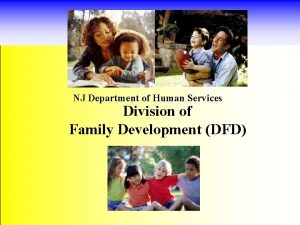Georgia Department of Human Services Division of Family














- Slides: 14

Georgia Department of Human Services/ Division of Family & Children Services: Strategies for Improving Child Welfare Services Presenter: Sharon L. Hill, Ph. D, DFCS Division Director Date: February 20, 2014 Georgia Department of Human Services

Vision, Mission and Core Values Vision Stronger Families for a Stronger Georgia. Mission Strengthen Georgia by providing Individuals and Families access to services that promote self-sufficiency, independence, and protect Georgia's vulnerable children and adults. Core Values • Provide access to resources that offer support and empower Georgians and their families. • Deliver services professionally and treat all clients with dignity and respect. Manage business operations effectively and efficiently by aligning resources across the agency. • Promote accountability, transparency and quality in all services we deliver and programs we administer. • Develop our employees at all levels of the agency.

Strategic Leadership Plans for All DFCS Section & Regional Directors Values Focus & Outcomes Child safety and family well-being are at Focus I. Safety & Well-being of Children the core of every thing we do. DFCS meets or exceeds critical outcomes related to the safety and well-being of the children and families we serve. A stable, competent, and professional workforce is essential to quality outcomes. Our commitments and obligations will be carried out with integrity, quality, and transparency. Focus II. Employee Development Staff perform in an exceptional manner and have opportunities for growth because we invest in them. Focus III. Accountability, Commitments & Integrity We maintain fidelity to plans and commitments and make adjustments when needed timely and transparently. *The Commitment to OUR Children We are most effective in achieving our Focus IV. Strong External Partnerships mission when we partner, develop, and We develop and maintain strong partnerships, maintain strong relationships with our alliances, and strategic relationships in order to clients, customers and external meet shared goals and objectives for children and stakeholders. families. .

Strategic Leadership Plans for All DFCS Section & Regional Directors • We worked together to develop common outcomes for each Focus Area • All directors have developed strategies, action plans and measurable goals for each Focus Area • Individual presentations on plans • Personal leadership development goal for each director • Monthly update on plans

Strategic Leadership Plans for All DFCS Section & Regional Directors • We worked together to develop common outcomes for each Focus Area • All directors have developed strategies, action plans and measurable goals for each Focus Area • Individual presentations on plans • Personal leadership development goal for each director • Monthly update on plans

Strategies for Improving Child Welfare Practices • Implement statewide 24/7 centralized intake system in Georgia, creating uniformity and standardization of response to reports of abuse and neglect (CPS Intake Communication Center) -System implemented in 8 of the 15 regions -Ability to monitor phone calls -Greater assurance that all reports are documented in SHINES Status: Currently 8 of 15 regions live; completed hiring of additional staff; readiness plan developed for future implementation • Review cases that have been “screened out” in the last 12 months Oct 2012 – Oct 2013 / then ongoing - Quality Assurance Team, Centralized Intake and Regional & County staff Status: Reviews completed on approximately 2, 500 cases; all screen outs to centralized intake are reviewed • Provide intensive training for staff to improve interviewing and investigative skills -Georgia Child Advocacy Centers will train DFCS case managers on how to interview children to gain the best information in order to make best decisions regarding their safety Status: Contract finalized; training will begin March 3, 2014 6

Strategies for Improving Child Welfare Practices, cont’d • Provide intensive training for staff to improve interviewing and investigative skills -Georgia Public Safety Center will provide training DFCS case managers on how to interview adults in order to best determine their capacity to provide care for their children. Status: Contract not yet finalized; anticipated training date for May 2014 • Establish internal safety panels to review/staff investigations and Family Support cases prior to closure to ensure decisions are appropriate for safety of children -DFCS subject matter experts from around the state • Establish an External Review Team to conduct review and provide recommendations to DFCS for practice enhancements -Tom Rawlings and Melissa Carter (both were formerly in the role of Office of the Child Advocate) • Predictive Analytics to identify risky factors that may increase likelihood of future injury to child -Andy Barclay, statistician, working with DFCS on this 7

Strategies for Improving Child Welfare Practices • Children’s Healthcare of Atlanta (CHOA) -Dr. Jordan Greenbaum and Dr. Nancy Fejma: Child Protection Health Team to provide training and consultation to staff around medical concerns as well as physical abuse • Casey Family Programs -Permanency Roundtables (multi-disciplinary staffing of children in foster care) -Cold Case Project (review of children who have been in foster care for extended periods of time) • National Resource Center for Child Protection -Consultation on developing Safety Response System (practice model) *Staffing plan developed to hire 175 child welfare staff by June 30, 2014; pending legislative approval. 8

Federal Outcomes Comparison: Alabama, Florida, Georgia, Kansas and Tennessee

Timeliness of Reunification: FFY 2008 -FFY 2011 Exits to reunification in less than 12 months: Of all children discharged from foster care to reunification in the year shown, who had been in foster care for 8 days or longer, what percent was reunified in less than 12 months from the date of the latest removal from home? National median = 69. 9% Alabama Florida Georgia Kansas Tennessee FFY 2008 63. 1 69. 7 60. 5 69. 5 73. 0 FFY 2009 61. 2 69. 5 58. 2 63. 2 72. 6 FFY 2010 64 72. 3 66. 4 67. 2 78. 2 FFY 2011 67. 1 73. 9 70. 6 67. 8 77. 0 Change (FFY 08 -FFY 11) 4. 0 4. 2 10. 1 -1. 7 4. 0 Source: FY 08 -FY 11 Child Welfare Outcomes Report Data (12/21/2012)

Timeliness of Reunification: FFY 2008 -FFY 2011 Exits to reunification, median stay: Of all children discharged from foster care to reunification in the year shown, who had been in FC for 8 days or longer, what was the median length of stay (in months) from the date of the latest removal from home until the date of discharge to reunification? National median = 6. 5 months (lower score is preferable in this measure) Alabama Florida Georgia Kansas Tennessee FFY 2008 9. 0 8. 1 10. 3 8. 2 7. 1 FFY 2009 FFY 2010 9. 1 8. 3 8. 0 7. 9 10. 7 9. 0 8. 8 7. 4 6. 5 Change FFY 2011 (FFY 08 -FFY 11) 8. 1 -0. 9 7. 9 -0. 2 7. 4 -2. 9 9. 0 0. 8 6. 8 -0. 3 Source: FY 08 -FY 11 Child Welfare Outcomes Report Data (12/21/2012)

Timeliness of Reunification FFY 2008 -FFY 2011 Re-entries to foster care in less than 12 months: Of all children discharged from foster care to reunification in the 12 -month period prior to the year shown, what percent re-entered foster care in less than 12 months from the date of discharge? National median = 15. 0% (lower score is preferable in this measure) Alabama Florida Georgia Kansas Tennessee FFY 2008 10. 6 13. 2 7. 9 8. 1 13. 4 FFY 2009 8. 6 15. 1 3. 5 7. 4 13. 0 FFY 2010 7. 8 14. 1 6. 1 8. 8 13. 5 FFY 2011 10. 1 15. 4 8. 9 8. 4 11. 8 Change (FFY 08 -FFY 11) -0. 5 2. 2 1. 0 0. 3 -1. 6 Source: FY 08 -FY 11 Child Welfare Outcomes Report Data (12/21/2012)

Timeliness of Adoption: FFY 2008 -FFY 2011 Children in care 17+ months, adopted by the end of the year: Of all children in foster care (FC) on the first day of the year shown who were in FC for 17 continuous months or longer, what percent was discharged from FC to a finalized adoption by the last day of the year shown? National median = 20. 2% Alabama Florida Georgia Kansas Tennessee FFY 2008 14. 0 29. 1 23. 2 25. 2 36. 6 FFY 2009 21. 0 30. 9 27. 4 36. 0 FFY 2010 18. 1 33. 1 30. 5 25. 2 37. 1 Change FFY 2011 (FFY 08 -FFY 11) 16. 1 2. 1 31. 7 2. 6 31. 1 7. 9 31. 1 5. 9 31. 8 -4. 8 Source: FY 08 -FY 11 Child Welfare Outcomes Report Data (12/21/2012)

Achieving Permanency for Children in Foster Care for Long Periods of Time Exits to permanency for children with TPR (termination of parental rights): Of all children who were discharged from foster care in the year shown, and who were legally free for adoption at the time of discharge , what percent was discharged to a permanent home prior to their 18 th birthday? A permanent home is defined as having a discharge reason of adoption, guardianship, or reunification (including living with relative). National median 96. 8% Alabama Florida Georgia Kansas Tennessee FFY 2008 94. 6 92. 5 91. 5 88. 3 92. 0 FFY 2009 96. 9 90. 7 92. 5 89. 0 91. 5 FFY 2010 92. 9 91. 9 92. 6 87. 1 91. 1 Change FFY 2011 (FFY 08 -FFY 11) 89. 1 -5. 5 91. 0 -1. 5 94. 9 3. 4 89. 4 1. 1 91. 7 -0. 3 Source: FY 08 -FY 11 Child Welfare Outcomes Report Data (12/21/2012)
 Georgia department of human resources
Georgia department of human resources Iowa department of health and human services
Iowa department of health and human services Seattle human services department
Seattle human services department Icg grant illinois
Icg grant illinois Milwaukee county health and human services
Milwaukee county health and human services Maine department of health and human services
Maine department of health and human services Delaware county department of human services
Delaware county department of human services Exosystem
Exosystem Wake county human services community services center
Wake county human services community services center Tiffany taylor georgia department of education
Tiffany taylor georgia department of education Georgia department of community health
Georgia department of community health Npu ranking
Npu ranking Georgia department of children and families
Georgia department of children and families Georgia department of audits
Georgia department of audits Georgia department of motor vehicle safety
Georgia department of motor vehicle safety
